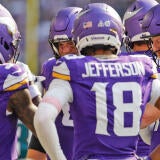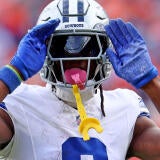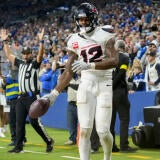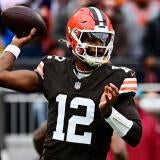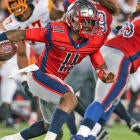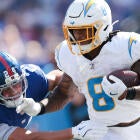5 biggest lessons from XFL Week 1: Running backs don't matter, Houston dominates with spread
Ben Gretch reviews the biggest takeaways from Week 1 in the XFL, beginning with a lack of clarity among the league's running backs early on.
Week 1 of the new XFL is in the books, and it was an exciting weekend with plenty of rule quirks to get used to. Between the new rules and other factors, there are some key differences to expect from this league that will impact Fantasy production. Early reactions to trends can provide a big advantage in DFS, so let's dive into what to expect in Week 2 and beyond.
1. Running backs don't matter
The most successful offenses we saw this weekend utilized the passing game, but there's another major factor here. The new timing rules mean that outside of the final two minutes of each half, the clock continues to run after the ball is spotted even after incompletions or plays that go out of bounds. In the final two minutes, on plays where a runner is tackled in bounds, the clock stops until the ball is spotted and five seconds have run off the 25-second play clock.
In other words, with some minor differences, all plays keep the clock running until the point at which all plays stop the clock. Outside of two minutes, you can keep the clock running while passing, and inside of two minutes the most a running play allows you to burn is 19 seconds if you take the play clock all the way down to one (so more like 15 seconds). Those changes are substantial; teams don't have much reason to avoid passing with a second-half lead. Relatedly, we didn't see leading teams racking up second-half rush attempts.
For the weekend, only two teams had a combined 20 rush attempts from their teams' backs, and one of them was Tampa Bay, who lost by 20. St. Louis was the other, and they were clearly the league's run-heaviest team — they ran on 59% of their offensive plays. But five of the other seven teams ran on 36% of their plays or fewer, with Dallas coming in at a 20.3% rush percentage. Los Angeles, Houston, Seattle and New York were the other pass-happy teams, in that order.
2. Road offenses struggled
With the exception of St. Louis overcoming the weekend's longest odds to upset Dallas in the final game of the weekend, the other road teams all lost by double-digit points. Even St. Louis only scored 15 points as the weekend's lowest-scoring victor, and they mostly seemed to hang around until a 37-yard quarterback draw and 41-yard catch-and-run on subsequent drives set up nine fourth-quarter points to take the road win. They were also facing a backup quarterback who struggled to get the ball down the field.
During the in-game sideline interviews we had access to, some players were talking about football shape being a different animal, and I can't imagine travel helped their stamina. I would think any potential home-field advantage will level out as the season rolls along, but I'm going to be wary of overreacting to subpar results from some of the visiting teams.
3. Mobile quarterbacks galore
Lamar Jackson broke Fantasy Football in the 2019 NFL season, and the XFL brought us more quarterback mobility that should be a major factor in picking Fantasy options. Jordan Ta'amu ran for 77 yards, Cardale Jones had 28, and the weekend's top quarterback Phillip Walker picked up 24 yards on the ground but showed plenty more rushing upside if he needs it — he only rushed four times because he was too busy carving up Los Angeles' defense through the air.
Tampa Bay backup Quinton Flowers also rushed for 34 and could see his role expand in the coming weeks — the Vipers made a point to use him more in the second half and feature a read-option offense, even while trailing. We'll also get Josh Johnson under center for Los Angeles at some point, and B.J. Daniels and his 2,000 career collegiate rushing yards made a brief appearance for Seattle and could see more playing time in the future. We could be looking at as many as six quarterbacks with big rushing upside across the league's eight offenses at some point this season.
4. Houston's offense looks great, and other positive signs
The Roughnecks put on a show in the Saturday night game, and Walker's ability to execute their spread offense made for plenty of Fantasy production. It's easy to see them as the most Fantasy-friendly offense going forward.
I also saw upside in DC's and New York's offenses, but an underrated option going forward will be Dallas. Backup quarterback Phillip Nelson completed 79% of 42 passes for just 209 yards — he checked down all game, with 15 of his 33 completions going to four different running backs (receiving upside for backs will be key to target). Landry Jones is expected to lead that offense going forward, and I'm hopeful we'll see him take more shots than Nelson did. Given the super high pass rate in Hal Mumme's system, that could mean big things down the road.
5. Shorter drives = more scoring?
The under hit in three of opening weekend's four games, but that was maybe expected as these offenses need some time to gel. But one thing that stood out was how the rules impacted starting field position. Kickoff infractions can have the ball placed as far as the opposing team's 45-yard line, while touchbacks bring it out to the 35 and returns under the new rules — the coverage team lines up on the opposing side of the field and doesn't get a running start — seemed to net more yards than is typical in the NFL. Punt rules also help returners and should create shorter fields.
While Week 1 offenses didn't exactly take advantage, my expectation going forward is we'll see some weeks with plenty of points. Touchdowns are always important, but these rules mean they should be expected to carry more relative weight to DFS contests than yardage. No offense totaled 400 yards — Houston, who had five offensive touchdowns, had just 315 yards from scrimmage. Tracking red zone usage could be a key to identifying upside, particularly for the running back position if we continue to see depressed touch counts.
